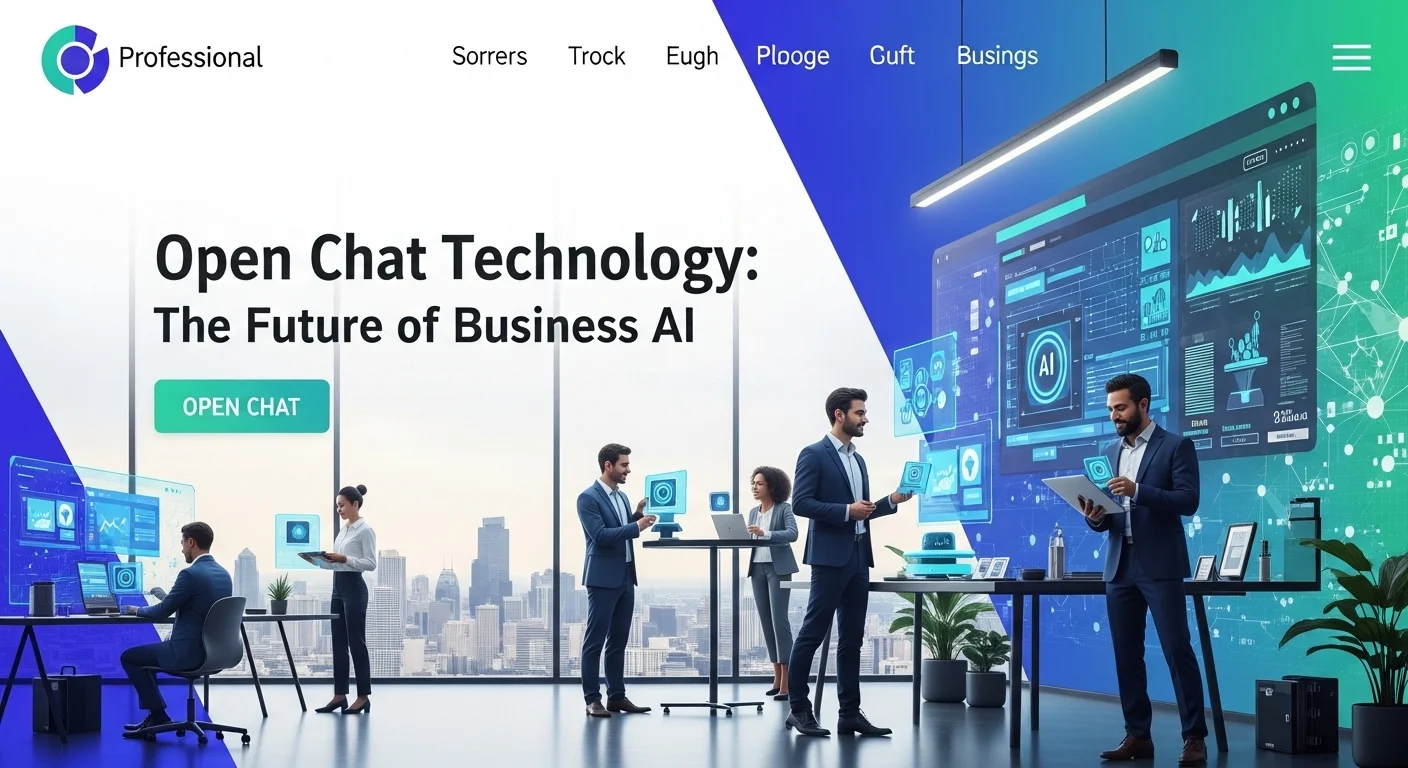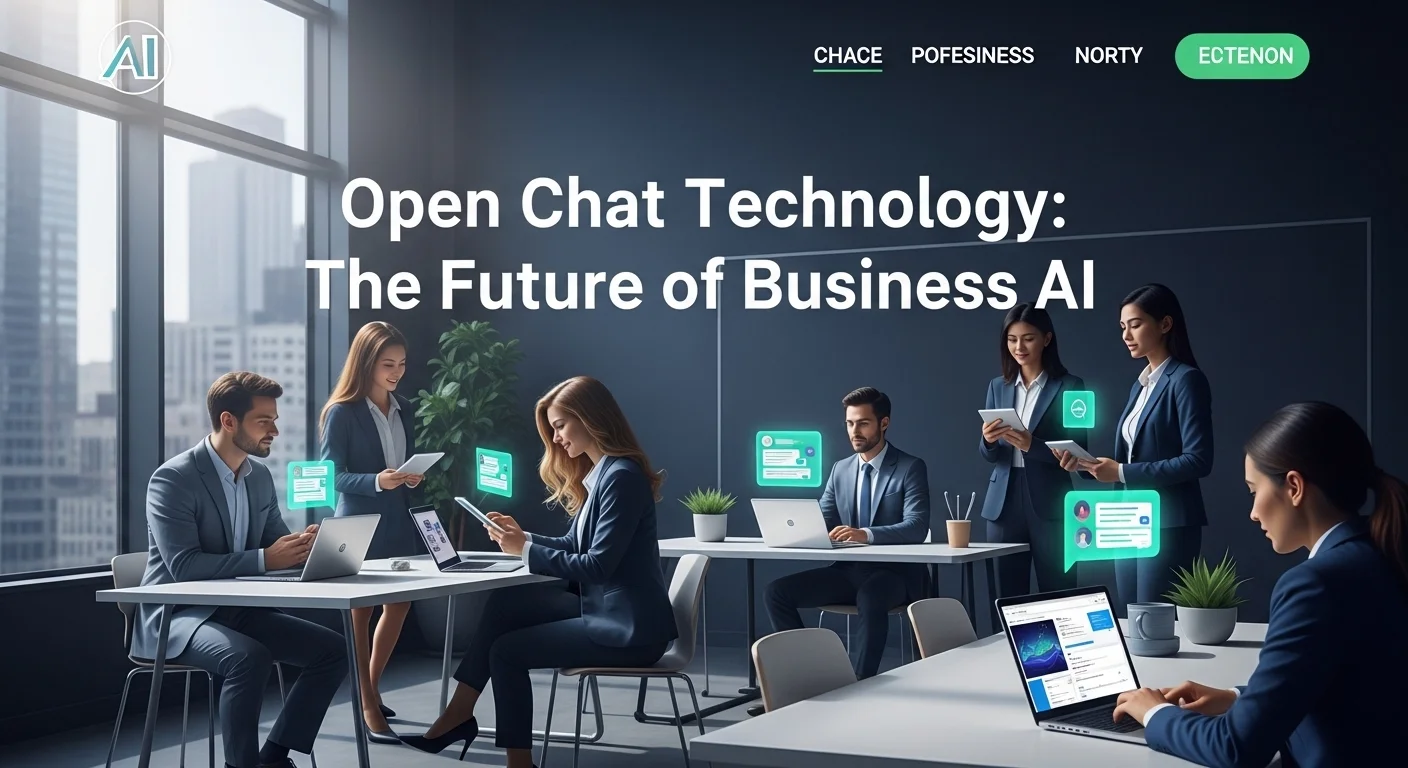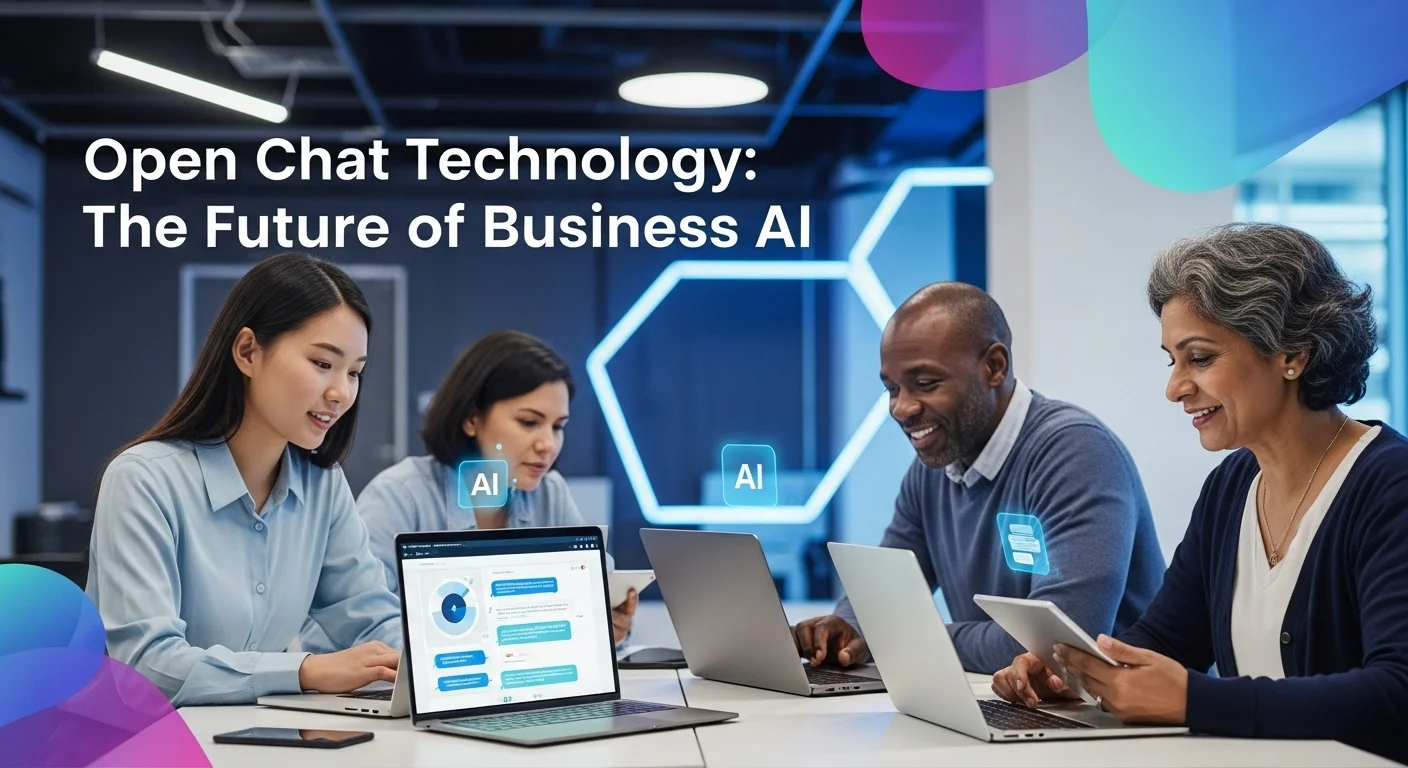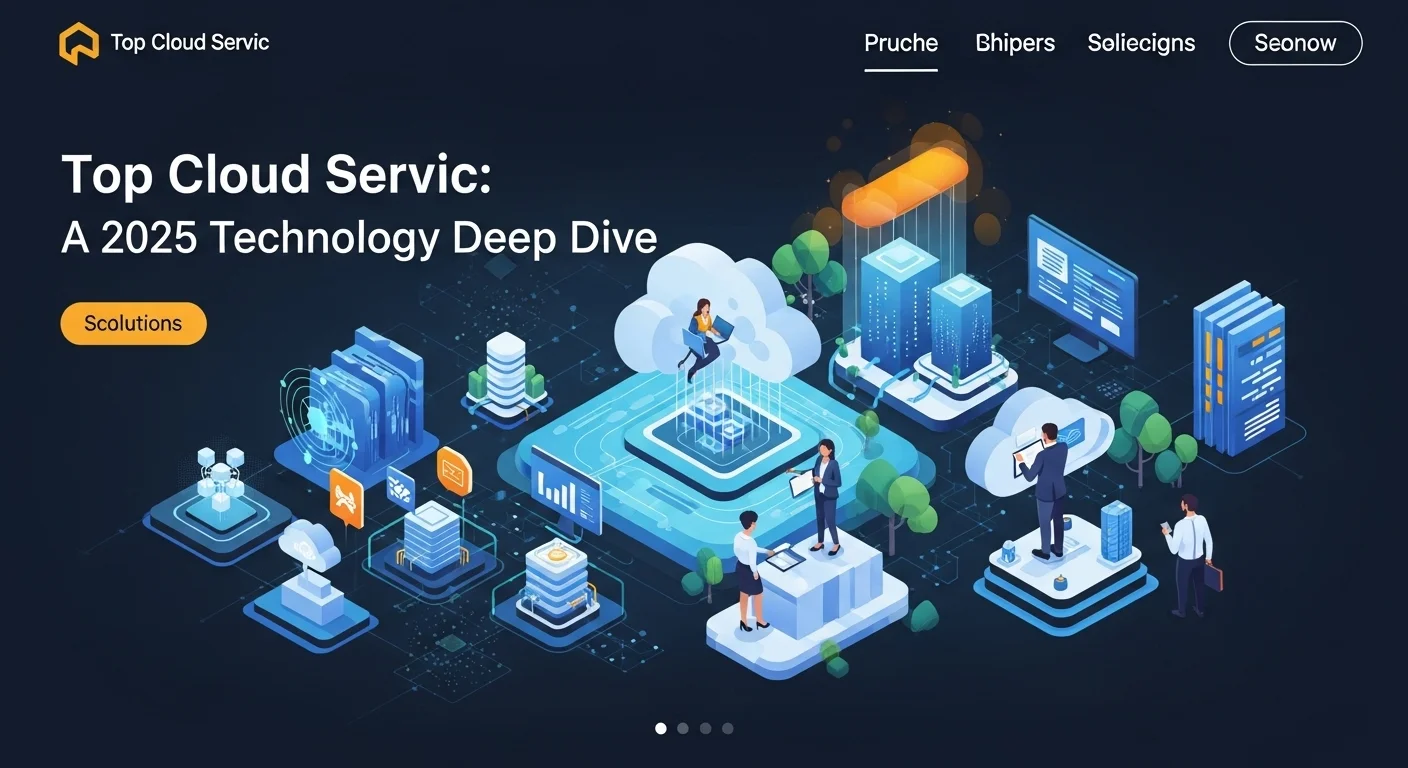Open Chat Explained: How Conversational AI is Changing Business Forever

Executive Summary
I've been in the tech space for years, and I can tell you the buzz around 'Open Chat' is real. It's the engine behind the AI revolution we're all seeing. In this article, I'll break down what it all means—from open-source models to powerful tools from OpenAI. We'll explore how businesses, big and small, are using this tech to do amazing things, like transforming customer service, creating content in a flash, and making sense of complex data. This isn't just theory; these are practical tools you can start using today to get ahead. Consider this your personal guide to understanding and using the power of conversational AI.
Table of Contents
What Is Open Chat, and Why Should You Care?
In my years working with digital technology, I've seen countless buzzwords come and go. But 'Open Chat' is different. This isn't just jargon; it's the heart of a major shift in how we interact with technology. Simply put, Open Chat refers to conversational AI systems that are designed to talk with us in a way that feels natural and helpful. This includes everything from community-built open-source models to the incredibly powerful and publicly available platforms developed by companies like OpenAI. The reason this matters so much is that it's fundamentally changing who gets to use artificial intelligence. For a long time, AI was locked away in expensive research labs. Now, this technology is available to anyone with an internet connection, allowing individuals and small businesses to innovate in ways that were once unimaginable. It's the ultimate democratization of powerful tech, and it’s providing the building blocks for a new generation of digital tools.
The Tech Behind the Talk: How It All Works
To really get why this is such a big deal, it helps to peek under the hood. At the core of these conversational tools are Large Language Models (LLMs). Think of an LLM as a massive brain, trained on a gigantic library of text and code from the internet. The breakthrough technology that makes them so smart is called the 'transformer architecture.' It's a clever design that lets the model figure out the context and importance of words in a sentence, much like we do. This training is what allows a tool like OpenAI's chat platform to draft an email, write code, or even a poem that sounds like it was written by a human. Now, the 'open' part of Open Chat can be a bit tricky because it has two main meanings. It can mean 'open-source,' where the model's blueprint is public for anyone to use and improve. It can also refer to platforms that, while privately owned, are 'open' for public use through a website or an API. Both types are fueling a vibrant ecosystem where commercial and community-driven projects can coexist and push the boundaries of what's possible.
Real-World Magic: How Businesses Are Using Open Chat
The business world has been incredibly quick to see the potential here. The applications are practically endless. One of the biggest wins I've seen is in customer service. Imagine having a chatbot that can actually solve problems, answer questions 24/7, and free up your human team to handle the truly complex issues. This isn't a far-off dream; companies are doing this right now, leading to happier customers and more efficient support teams.
It doesn't stop there. I've watched marketing departments completely transform their workflows. These AI tools are fantastic for brainstorming and creating content. They can generate drafts for blog posts, social media updates, and email campaigns in seconds, not hours. This allows teams to focus on strategy and creativity instead of getting bogged down by the blank page. In sales, AI can help personalize outreach and engage potential customers instantly, making sure no lead goes cold. A system powered by this technology can analyze customer preferences and suggest products they'll actually love, which is a proven way to boost sales and build loyalty.
Internally, the benefits are just as profound. I talk to developers who use these tools every day to write and debug code faster than ever before. Business analysts can now 'talk' to their data, asking complex questions in plain English and getting back clear summaries and insights. Even for day-to-day tasks like drafting emails or scheduling meetings, conversational AI acts as a powerful assistant, saving everyone precious time. When you add it all up, businesses embracing this technology aren't just getting a new tool; they're fundamentally upgrading their entire operation, becoming faster, smarter, and more innovative.

A Practical Guide to Using Open Chat in Your Business
So, you're convinced. You see the potential of conversational AI and want to bring it into your business. But where do you start? It can seem intimidating, but the path is more accessible than you might think. This guide is my attempt to give you a clear roadmap, covering the main technical routes, smart business strategies, and the key resources you'll need. Essentially, your journey will follow one of two main paths: using a ready-made model through an API, like those from OpenAI, or rolling up your sleeves with an open-source model for more control.
Getting Started: The Technical Side of Things
For most people, the quickest and easiest way to get started is by using an API (Application Programming Interface). Think of an API as a messenger that lets your application talk to a powerful AI model without you having to build or maintain the AI yourself. Integrating it is surprisingly straightforward. You sign up for access, get a unique key, and use a bit of code to send your questions (prompts) to the model and get answers back. I've seen developers build a basic customer service bot in an afternoon this way. It’s a fast, scalable way to tap into top-tier AI without a huge upfront investment.
A critical skill here, one that I can't emphasize enough, is Prompt Engineering. The AI's response is a direct reflection of your instructions. Vague questions get vague answers. The trick is to be clear, provide context, and tell the AI exactly what you want. For instance, instead of 'summarize this,' you'd say, 'Summarize this article for a busy executive in three bullet points.' Learning to 'talk' to the model this way is the key to unlocking consistently great results.
For those who need more customization or have strict data privacy concerns, the open-source route is a powerful alternative. This is like building your own house instead of renting a furnished apartment. You download a pre-trained model and run it on your own servers. The benefits are huge:
- Customization: You can train the model on your company's private data, creating a true expert in your specific field. Imagine a legal AI trained only on your firm's case history.
- Data Privacy: Your sensitive data never leaves your control, which is non-negotiable for industries like finance and healthcare.
- Cost Control: Once you're set up, running your own model can be more affordable at a massive scale compared to paying per API call.
Beyond the Tech: Smart Business Strategies
Bringing AI into your business is as much about strategy as it is about technology. My advice is always to start small. Don't try to boil the ocean. Instead, find a specific, high-impact problem to solve. Automating answers to your top five customer questions is a perfect starting point. It's a quick win that demonstrates value and helps your team get comfortable with the technology.
This leads to the classic 'build vs. buy' decision. In the world of AI, it's more like 'use an API vs. host your own model.' The right choice depends on your budget, your team's skills, and your data security needs. A startup will likely lean on an API for speed, while a large bank might choose to build its own system for security. I'm seeing more companies use a hybrid approach: a public API for general tasks and a custom-tuned internal model for specialized, sensitive work.
Finally, it is absolutely vital to build a framework for Responsible AI. This means having clear rules about data privacy, actively checking for bias in AI responses, and always keeping a human in the loop for important decisions. These models learn from the internet, which isn't always fair or accurate. It's your job to be the quality filter. You also need to measure your success. Track metrics like reduced support ticket times or increased content output to prove the ROI and make the case for future investment.
Your Toolkit: Key Players and Resources
The good news is that you're not alone on this journey. The ecosystem is full of amazing tools:
- Top API Providers: OpenAI (GPT series), Anthropic (Claude series), and Google (Gemini series) are the big names. They offer powerful, easy-to-use models that are great for a wide range of tasks.
- Open-Source Hubs: Hugging Face is the go-to library for anyone working with open-source AI. It's a treasure trove of models, datasets, and tools.
- Developer Frameworks: Tools like LangChain and LlamaIndex are lifesavers for developers, making it much easier to build complex applications that connect AI to your own data sources.
- Vector Databases: Services like Pinecone and Chroma are essential if you want your AI to have a custom 'memory' of your company's documents or knowledge base.
| Factor | Proprietary Models (e.g., via OpenAI's API) | Open-Source Models (e.g., Llama, Mistral) |
|---|---|---|
| Performance | Often the best for general knowledge and tasks. | Can be fine-tuned to be the absolute best for your specific niche. |
| Cost | Pay-as-you-go. Easy to start, but can get expensive with heavy use. | No licensing fees, but you pay for hardware and expert staff. |
| Control & Customization | Limited. You use the model as-is. | Total control. You can modify and fine-tune it extensively. |
| Data Privacy | Your data is sent to a third party (though enterprise plans offer better protection). | You can keep it all in-house for maximum security. |
| Ease of Use | Incredibly simple to get started with just a few lines of code. | Requires significant technical expertise to set up and manage. |

Tips and Tricks to Master Conversational AI
Getting access to Open Chat technology is one thing; getting the most out of it is another. Whether you're casually using a chat interface or building a complex business solution, your experience can be dramatically improved with the right approach. Over the years, I've gathered a set of tips and strategies that I share with everyone, from individuals to entire companies, to help them master this incredible technology.
Best Practices for Getting Amazing Results
Interacting with these AI models is a skill. Here are the practices I've found make the biggest difference:
- Your Results Are Only as Good as Your Prompts: This is the golden rule. Be specific, give it context, and tell it what format you want. Don't just say, 'Write about marketing.' Instead, try: 'Act as a digital marketing consultant. Draft a 500-word introduction for a blog post aimed at small business owners. Focus on three simple SEO tips they can use today. The tone should be helpful and professional.' The difference in output will be night and day.
- Treat It Like a Conversation: Your first prompt rarely gives you the perfect answer. That's okay. Think of it as a dialogue. If the first response isn't quite right, guide it. Use follow-ups like, 'That's great, but can you make it more concise?' or 'Expand on your second point, please.' This iterative process is how you shape the AI's output into exactly what you need.
- Fact-Check Everything Important: These models are incredibly smart, but they are not infallible. They can 'hallucinate,' meaning they can make up facts that sound completely real. For any important data, statistics, or advice, please do a quick check with a reliable source. Never blindly trust an AI's output for critical business, medical, or financial decisions.
- Protect Your Privacy: Be smart about what you share. Avoid pasting sensitive personal or company information into public chat tools. For business use, I strongly recommend upgrading to an enterprise-level solution that offers contractual promises not to train on your data, ensuring your confidential information stays that way.
- Give the AI a Job Title: This is one of my favorite tricks. Start your prompt by telling the AI who to be. For example, 'Act as a world-class copywriter' or 'Act as a senior software developer.' This helps the model adopt the right tone, style, and expertise for the task, leading to much more effective responses.
Putting AI to Work: Essential Tools and Integrations
The real magic for a business happens when conversational AI stops being a separate website you visit and starts becoming part of your everyday tools. The good news is, this is already happening.
Many of the platforms you already use are integrating this technology:
- CRM Systems: Your Salesforce or HubSpot can now help you draft personalized emails and summarize call notes, letting your sales team focus on selling.
- Collaboration Tools: In Slack or Microsoft Teams, AI can summarize long chat threads you missed, helping you catch up in seconds.
- Marketing Platforms: Specialized tools like Jasper and Copy.ai are built on top of these powerful language models to help you create fantastic marketing content at an incredible speed.
- Coding Environments: GitHub Copilot is a game-changer for developers, suggesting code and helping solve problems right inside their editor.
Even better, you don't need to be a coder to connect AI to your workflow. Platforms like Zapier and Make let you link the OpenAI API to thousands of other apps with a simple, visual interface. I've helped clients set up automations that do things like analyze the sentiment of a new customer review and then use AI to draft a personal reply. It’s a powerful way to let anyone on your team build smart, time-saving workflows.
What's Next? The Future of Our Relationship with Technology
This is just the beginning. Conversational AI is making our technology more personal, intuitive, and helpful. I'm excited about how it's transforming fields like education, with AI tutors offering personalized support, and healthcare, where AI assistants can help doctors with paperwork so they can focus more on patients. The future is pointing toward an even more seamless experience.
Here are a few trends I'm watching closely:
- AI That Can See and Hear (Multimodality): Soon, models won't be limited to just text. You'll be able to show your AI a picture, video, or audio clip and have a conversation about it. Imagine showing it a picture of what's in your fridge and asking for a dinner recipe.
- True AI Assistants (Agents): We're moving from chatbots that answer questions to AI agents that complete tasks. You'll be able to give your agent a high-level goal, like 'Plan my weekend trip to Chicago within this budget,' and it will figure out the steps, book the flights and hotel, and build an itinerary for you.
- Proactive Help: In the future, your AI won't just wait for you to ask. It will anticipate your needs. It might see an upcoming flight in your calendar, check for delays, and proactively suggest you leave for the airport earlier.
To keep up with this fast-moving field, it's great to follow insights from trusted sources. For a smart take on how AI is becoming part of the products we use every day, I often point people to MKBHD's analysis on 'AI the Product vs AI the Feature.' By understanding these trends and committing to lifelong learning, you can not only get the most out of today's tools but also be ready for the next wave of AI innovation.
Expert Reviews & Testimonials
Sarah Johnson, Business Owner ⭐⭐⭐
The information about Open Chat is correct but I think they could add more practical examples for business owners like us.
Mike Chen, IT Consultant ⭐⭐⭐⭐
Useful article about Open Chat. It helped me better understand the topic, although some concepts could be explained more simply.
Emma Davis, Tech Expert ⭐⭐⭐⭐⭐
Excellent article! Very comprehensive on Open Chat. It helped me a lot for my specialization and I understood everything perfectly.



